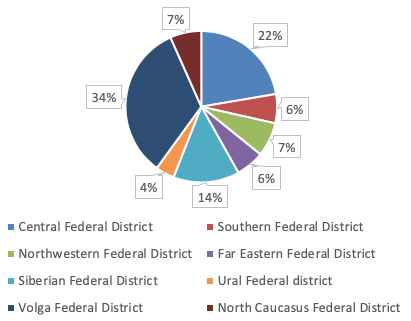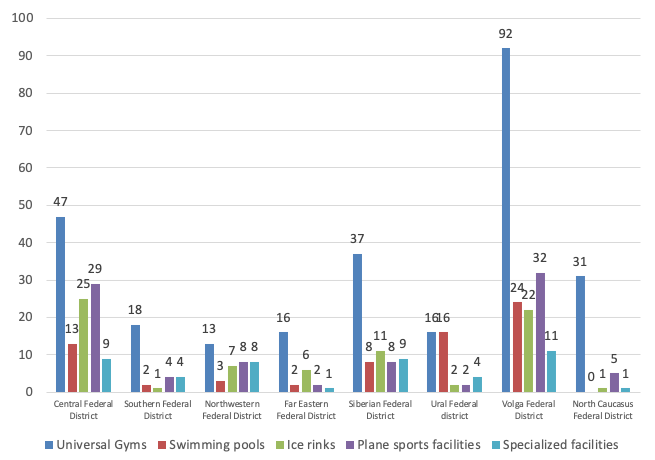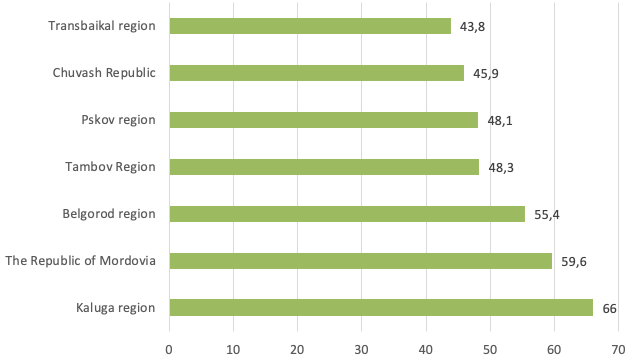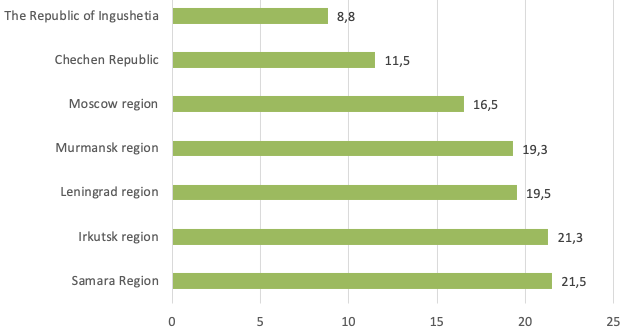

Vol. 40 (Number 30) Year 2019. Page 8
DAVYDOVA, Elena V. 1; FAGINA, Stanislava S. 2; VASHLYAEVA, Irina V. 3 y VOLOVIK, Tatiana V. 4
Received: 13/05/2019 • Approved: 30/08/2019 • Published 09/09/2019
ABSTRACT: The priority direction of the state policy in the development of physical culture and mass sports is to provide opportunities for citizens to systematically engage in physical culture and mass sports and carry out their livelihoods on the principles of a healthy lifestyle. All provisions on improving the livelihood of Russian citizens with an infrastructure for a healthy lifestyle and sports are reflected in the Strategy and in the State Program for the Development of Physical Culture and Sports. The study showed that the ratio of the availability of sports facilities in the territory of the Russian Federation is extremely heterogeneous. The ratio of the indicator of the leader region in the provision of sports facilities (Kaluga region) and the region of the outsider (Republic of Ingushetia) is 7.42 times. In order to modernize the infrastructure, it is necessary to achieve regulatory indicators of the provision of sports facilities in the territory of all constituent entities of the Russian Federation in order to reduce and smooth out regional differentiation in terms of sports and physical culture, as well as to enable people to strengthen their physical and intellectual development. |
RESUMEN: La dirección prioritaria de la política estatal en el desarrollo de la cultura física y los deportes de masas es brindar oportunidades a los ciudadanos para que se involucren sistemáticamente en la cultura física y los deportes de masas y lleven a cabo sus medios de subsistencia sobre los principios de un estilo de vida saludable. Todas las disposiciones sobre la mejora de los medios de vida de los ciudadanos rusos con una infraestructura para un estilo de vida saludable y deportes se reflejan en la Estrategia y en el Programa Estatal para el Desarrollo de la Cultura Física y el Deporte. El estudio mostró que la relación entre la disponibilidad de instalaciones deportivas en el territorio de la Federación Rusa es extremadamente heterogénea. La proporción del indicador del líder de la provisión de instalaciones deportivas (región de Kaluga) y la región del forastero (República de Ingushetia) es 7.42 veces. Para modernizar la infraestructura, es necesario lograr indicadores reguladores de la provisión de instalaciones deportivas en el territorio de todas las entidades constitutivas de la Federación de Rusia, a fin de reducir y suavizar la diferenciación de las regiones en términos del desarrollo de la cultura física y deportiva, así como permitir que las personas fortalezcan su desarrollo físico e intelectual. |
The role of physical culture and sports is great, since its goal is to improve the health of the population, as well as the development of physical and intellectual abilities of a person (Baade, 1996, Burillo et al., 2011). Activities for the development of mass sports require the expansion of the material and technical base at the regional level.
The development of physical culture and sports contributes to the preservation and strengthening of public health, which is a priority task of the executive authorities. At the same time, the state of the infrastructure of this industry, based on the Soviet legacy, namely, the surviving sports facilities of that time, reduces the motivation of the active part of people to go in for physical culture and sports (Davies, 2011, Downward et al., 2014, Hallmann et al., 2012). The introduction of new sports facilities with the modernization of an existing base, contributes to an increase in the rate of development of physical culture and sports in various regions of Russia.
The purpose of the study was to determine the differences in the level of provision and accessibility of sports infrastructure in the regions of the Russian Federation.
The sports infrastructure and physical activity of the population of the Russian Federation are directly proportional, and therefore, the quantity and quality of sports facilities should directly affect the physical activity of citizens. In modern financial and economic conditions, attracting investment is a solution to the problems of developing the sports infrastructure in Russia. There are well-established ways to attract investments, thanks to which an investor is able to find the necessary sources of financing for the implementation of his business projects (Van den Hurk & Verhoest, 2015).
The article used a comparative analysis of the material and technical security of the population involved in sports. The calculations of the provision ratio of the population with sports infrastructure are based on the adopted average norms and standards for the needs of the subjects of the Russian Federation in physical education and sports in accordance with Decree of the Government of the Russian Federation No. 1683 – R. "On the method of determining the regulatory needs of the constituent entities of the Russian Federation in social infrastructure facilities". The method is used to identify deviations of actual indicators from the standard.
Graphic and cluster methods were used to visualize items of expenditure and to represent the share of funds allocated for the development and modernization of sports and physical culture in the structure of general budget expenditures (Zyukin & Pozhidaeva, 2014). On the basis of the distribution structure of the regional budget funds, an analysis of the financing of various industries was carried out, and trends of integration between them and the sphere of physical culture and sports were identified. At the same time, the expenses determined by the executive authorities are based on presidential decrees aimed at developing mass sports.
At present, Russia is implementing the federal target program "Development of Physical Culture and Sports in the Russian Federation for 2016-2020", the goals of which are to create conditions that enable citizens to systematically engage in physical education and sports, and increase the efficiency of training athletes in sports of the highest achievements . According to the results of the program in the direction of "Mass Sport" for 2016-2018 financing the construction of the largest number of sports facilities was carried out in the Volga Federal District – 215 facilities. This is followed by the Central Federal District – 144 facilities, the Siberian Federal District – 91 facilities, the North-West Federal District – 47 facilities, the North Caucasus Federal District – 43 facilities, the Southern Federal District – 40 facilities, the Far Eastern Federal District – 39 facilities, the Ural Federal District – 26 facilities. However, despite the successful implementation of the Program, it should be noted that about 80% of the activities implemented in the field of sports are carried out in regions with a high level of provision of sports facilities, but throughout the country there is a significant difference in the indices of provision among regions and federal districts. The number of sports facilities built by federal districts is presented in Figure 1.
Figure 1
Number of sports facilities built
by federal districts, 2016-2018, %

Source: Compiled by the authors on the basis of data from the
Ministry of Sport of the Russian Federation. Statistical information.
As of the beginning of 2019, there are 231,050 sports facilities in Russia, of which 134,950 are flat structures, 91,300 are sports halls and 4,800 are swimming pools (Figure 2). According to analysts, the financial turnover of the sports industry in the public sector of the Russian economy is about $ 200 billion a year.
In total in 2013-2020 about 1,717 billion rubles will be allocated for the development of the sports industry within the framework of the state program “Development of physical culture and sport”. A significant part of these funds will be invested to the development of sports infrastructure. It is infrastructure investments that can serve as the most important tool for implementing the state’s social and economic policy, which, by investing in certain infrastructure projects, motivates private capital to take part in their implementation.
Figure 2
Quantitative indicators of the construction of sports facilities
in federal districts of Russia at the beginning of 2019

Source: Compiled by the authors on the basis of data from the
Ministry of Sport of the Russian Federation. Statistical information.
The provision of sports facilities in Russia varies considerably from region to region. Very few facilities of this type in the regions of Kostroma and Tver. The Krasnoyarsk Territory is in a somewhat better position. For comparison, in Japan sports facilities built 30% more than the population needs for active sports. In Finland 20% more. Russia belongs to the countries with an average level of provision the population with sports facilities (at the moment 25%). The lack of sports grounds creates the high cost of their operation.
The government of the Russian Federation has set the goal of reaching a 50% level in the country of providing the population with sports facilities by 2020, i.e. double their number. The government program also envisages that by this time it will be possible to attract 40% of Russians to regular physical education and sports. And if, with stable financing, the first task seems to be quite feasible, then the preferences of the people rarely depend directly on the number of facilities built.
Figure 3
Constituent entities of the Russian Federation
with high availability of sports facilities

Source: Compiled by the authors on the basis of data from the Ministry
of Sport of the Russian Federation. Statistical information.
------
Figure 4
Constituent entities of the Russian Federation
with low availability of sports facilities

Source: Compiled by the authors on the basis of data from the Ministry
of Sport of the Russian Federation. Statistical information
As follows from Figures 3 and 4, the ratio of the provision of sports facilities in the territory of the Russian Federation is extremely heterogeneous. The ratio of the indicator of the leader of the provision of sports facilities (Kaluga region) and the region of the outsider (Republic of Ingushetia) is 7.42 times. The active development of sports infrastructure in some regions of the Russian Federation has allowed, for the time being, achieving the value of the indicator recorded in the Strategy in 51 regions. In five regions (Belgorod, Kaluga, Pskov, Tambov regions and the Republic of Mordovia), the target value set for 2020 has been reached.
It should be noted that the level of provision of the population with sports facilities does not guarantee adherence to an active lifestyle. For example, the provision of sports facilities in Dmitrov near Moscow is 24%, and the proportion of citizens who regularly go in for sports is 29%. Another example: in Sergiev Posad, the availability of sports facilities is only 8%, while the share of citizens-athletes exceeds 17%. Probably, in Sergiev Posad, the organizers of sports events are working more actively with the population, which once again underlines the importance of the human factor in promoting an active lifestyle. The ratio of the number of sports facilities and the population in different regions and municipalities varies. However, the need for them is also different. And here we are talking not only about the size of the water mirror or the areas of sports halls and flat structures, but also about the priorities, traditions and needs of various sports facilities, as well as the financial capabilities of the regions and their inhabitants.
The concept of preferential funding for high-profile sports is relegated to second place. In recent years, this area has been modernized, transition to per capita funding of institutions providing sports training, increasing the material and technical base of sports schools, improving the system of sports events, monitoring the distribution of subsidies from the federal budget to the budgets of the constituent entities of the Russian Federation for preparing sports reserves in basic sports .
In order to modernize the infrastructure, it is necessary to achieve regulatory indicators of the availability of sports facilities in all the constituent entities of the Russian Federation, in order to reduce and smooth out the differentiation of regions in terms of sports and physical education, and also to enable people to strengthen their physical and intellectual development (Seclen-Palacin & Jacoby, 2003, Jones, 2001).
At the same time, the sports development policy aimed at the development of top-level sports is outdated, since mass sport is a priority for the development of the industry. Some regions of the Russian Federation (Belgorod and Tambov oblasts) are developing this area, as evidenced by their achievement of regulatory indicators on the material and technical base, but, as a rule, funding comes from the regional budget. Thus, infrastructure development is most dependent on state policy and support, as well as the intraregional distribution of financial resources.
Baade, R. A. (1996). Professional sports as catalysts for metropolitan economic development. Journal of urban affairs, 18(1), 1-17.
Burillo, P., Barajas, Á., Gallardo, L., & García-Tascón, M. (2011). The influence of economic factors in urban sports facility planning: a study on Spanish Regions. European Planning Studies, 19(10), 1755-1773.
Davies, L. E. (2011). Using sports infrastructure to deliver economic and social change: Lessons for London beyond 2012. Local Economy, 26(4), 227-231.
Downward, P., Lera-Lopez, F., & Rasciute, S. (2014). The correlates of sports participation in Europe. European journal of sport science, 14(6), 592-602.
Hallmann, K., Wicker, P., Breuer, C., & Schönherr, L. (2012). Understanding the importance of sport infrastructure for participation in different sports–findings from multi-level modeling. European sport management quarterly, 12(5), 525-544.
Jones, C. (2001). A level playing field? Sports stadium infrastructure and urban development in the United Kingdom. Environment and Planning A, 33(5), 845-861.
Ministry of Sports of the Russian Federation. Statistical information. [Electronic resource] - Access mode: https: // www. minsport.gov.ru/sport/physical-culture/statisticheskaya-inf/
Seclen-Palacin, J. A., & Jacoby, E. R. (2003). Sociodemographic and environmental factors associated with sports physical activity in the urban population of Peru. Revista panamericana de salud publica= Pan American journal of public health, 14(4), 255-264.
Van den Hurk, M., & Verhoest, K. (2015). The governance of public–private partnerships in sports infrastructure: Interfering complexities in Belgium. International Journal of Project Management, 33(1), 201-211.
Zyukin, D. A., & Pozhidaeva, N. A. (2014). Improving the approaches of applying the cluster analysis method in economic research. Scientific Almanac of the Central Chernozem Region, (3), 50-52.
1. Senior teacher, Physical education and sports department, Ural State University of Economics (62, 8 Marta St., Ekaterinburg, 620144, Russian Federation; e-mail: sports-department@rambler.ru
2. Teacher, Physical education and sports department, Ural State University of Economics (62, 8 Marta St., Ekaterinburg, 620144, Russian Federation; e-mail: faginastasya@mail.ru
3. Senior teacher, Physical education and sports department, Ural State University of Economics (62, 8 Marta St., Ekaterinburg, 620144, Russian Federation; e-mail: i.v.vashlyaeva@gmail.com
4. Senior teacher, Physical education and sports department, Ural State University of Economics (62, 8 Marta St., Ekaterinburg, 620144, Russian Federation; e-mail: volovik1410@mail.ru